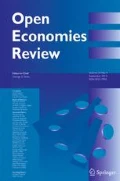Abstract
Motivated by recent research suggesting that uncertainty and financial shocks have become the most important sources of business cycle fluctuations, we assess the relative importance of monetary policy, uncertainty, and financial shocks in explaining key macroeconomic variations. Using a Bayesian monetary structural vector autoregressive model augmented with measures of uncertainty and tightness of financial conditions, we identify monetary policy, uncertainty, and financial shocks based on a penalty function approach. We find that uncertainty shocks have become a relatively more important source of output fluctuations than traditional monetary policy shocks and financial shocks. We also find that monetary policy shocks outperform uncertainty and financial shocks in explaining inflation dynamics and that financial shocks are relatively more important than monetary policy and uncertainty shocks in explaining the swings in the stock market. However, these shocks are not the major driver of exchange rates.
















Similar content being viewed by others
Notes
Our results are identical if the restrictions are binding for as short as 2 months or as long as 6 months.
References
Arellano C, Bai Y, Kehoe PJ (2019) Financial frictions and fluctuations in volatility. J Polit Econ 127:2049–2103
Barnett WA, Liu J, Mattson RS, Van den Noort J (2013) The new CFS Divisia monetary aggregates: Design, construction, and data sources. Open Econ Rev 24:101–124
Barsky RB, Sims ER (2011) News shocks and business cycles. J Monet Econ 58:273–289
Baumeister C, Hamilton JD (2018) Inference in structural vector autoregressions when the identifying assumptions are not fully believed: Re-evaluating the role of monetary policy in economic fluctuations. J Monet Econ 100:48–65
Bekaert G, Hoerova M, Lo Duca M (2013) Risk, uncertainty and monetary policy. J Monet Econ 60:771–788
Belongia MT, Ireland PN (2015) Interest rates and money in the measurement of monetary policy. J Business Econ Stat 33:255–269
Bloom N (2009) The impact of uncertainty shocks. Econometrica 77:623–685
Bloom N, Floetotto M, Jaimovich N, Saporta-Eksten I, Terry SJ (2018) Really uncertain business cycles. Econometrica 86:1031–1065
Caldara D, Fuentes-Albero C, Gilchrist S, Zakrajšek E (2016) The macroeconomic impact of financial and uncertainty shocks. Europ Econ Rev 88:185–207
Canova F, De Nicolo G (2002) Monetary disturbances matter for business fluctuations in the G-7. J Monet Econ 49:1131–1159
Christiano LJ, Motto R, Rostagno M (2014) Risk shocks. Ame Econ Rev 104:27–65
Cushman DO, Zha T (1997) Identifying monetary policy in a small open economy under flexible exchange rates. J Monet Econ 39:433–448
Davis SJ (2019) Rising policy uncertainty. NBERWorking Paper 26243
Del Negro M, Schorfheide F (2011) Bayesian macroeconometrics. In: Geweke J, Koop G, Van Dijk H (eds) Handbook of Bayesian econometrics. (Chapter 7). Oxford University Press, Oxford
Dery C, Serletis A (2019) Interest rates, money, and economic activities. macroeconomic dynamics (forthcoming)
Dery C, Serletis A (2020a) Monetary policy and economic fluctuations. mimeo, department of economics. University of Calgary, Canada
Dery C, Serletis A (2020b) Uncertainty, monetary policy, and leverage shocks. mimeo, department of economics. University of Calgary, Canada
Dornbusch R (1976) Expectations and exchange rate dynamics. J polit Econ 84:1161–1176
Eichenbaum M, Evans CL (1995) Some empirical evidence on the effects of shocks to monetary policy on exchange rates. Quart J Econ 110:975–1009
Faust J (1998) The robustness of identified VAR conclusions about money. Carnegie-Rochester Conf Series Public Policy 49:207–244
Fry R, Pagan A (2011) Sign restrictions in structural vector autoregressions: A critical review. J Econ Lit 49:938–60
Gertler M, Karadi P (2015) Monetary policy surprises, credit costs, and economic activity. Ame Econ J Macroecon 7:44–76
Gilchrist S, Zakrajšek E (2012) Credit spreads and business cycle fluctuations. Ame Econ Rev 102:1692–1720
Gilchrist S, Sim JW, Zakrajšek E (2014) Uncertainty, financial frictions, and investment dynamics. national bureau of economic research, No. w20038
Hansen N, Müller SD, Koumoutsakos P (2003) Reducing the time complexity of the derandomized evolution strategy with covariance matrix adaptation (CMA-ES). Evol Comput 11:1–18
Jadidzadeh A, Serletis A (2019) The demand for assets and optimal monetary aggregation. J Money Credit Banking 51:929–952
Jurado K, Ludvigson SC, Ng S (2015) Measuring uncertainty. Am Econ Rev 105:1177–1216
Kim S, Roubini N (2000) Exchange rate anomalies in the industrial countries: A solution with a structural VAR approach. J Monet Econ 45:561–586
Kurmann A, Otrok C (2013) News shocks and the slope of the term structure of interest rates. Am Econ Rev 103:2612–32
Lucas R Jr (1972) Expectations and the neutrality of money. J Econ Theor 4:103–124
Mountford A, Uhlig H (2009) What are the effects of fiscal policy shocks?. J Appl Econ 24:960–992
Preston AJ (1978) Concepts of structure and model identifiability for econometric systems. Stability and Inflation 275-97
Rogers J, Xu J (2019) How well does economic uncertainty forecast economic activity? Finance and economics discussion series 2019-085. Washington: Board of governors of the federal reserve system, https://doi.org/10.17016/FEDS.2019.085
Scholl A, Uhlig H (2008) New evidence on the puzzles: Results from agnostic identification on monetary policy and exchange rates. J Int Econ 76:1–13
Uhlig H (2005) What are the effects of monetary policy on output? Results from an agnostic identification procedure. J Monet Econ 52:381–419
Wolf CK (2020) SVAR (Mis-) identification and the real effects of monetary policy shocksamerican economic journal: Macroeconomics (forthcoming)
Acknowledgments
We would like to thank the Editor, George Tavlas, and an anonymous referee for comments that greatly improved the paper
Author information
Authors and Affiliations
Corresponding author
Additional information
Publisher’s Note
Springer Nature remains neutral with regard to jurisdictional claims in published maps and institutional affiliations.
Rights and permissions
About this article
Cite this article
Dery, C., Serletis, A. The Relative Importance of Monetary Policy, Uncertainty, and Financial Shocks. Open Econ Rev 32, 311–333 (2021). https://doi.org/10.1007/s11079-020-09602-6
Published:
Issue Date:
DOI: https://doi.org/10.1007/s11079-020-09602-6




